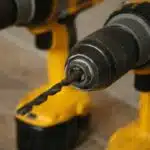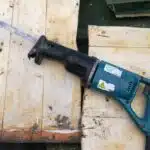Belt sanders are one of the most versatile and powerful tools in a woodworker’s arsenal. They can be used for everything from shaping rough lumber to smoothing out intricate details on finished pieces. However, they can also be intimidating to use for beginners who have not yet mastered their technique. In this article, we will explore the basics of how to use a belt sander effectively and safely.
The key to using a belt sander successfully is understanding its capabilities and limitations. While it can remove material quickly, it can also cause damage if used improperly. Therefore, it is essential to learn proper techniques and safety precautions before attempting any woodworking projects with this tool. Additionally, knowing how to choose the right type of belt for each task will ensure that you achieve the desired results without damaging your workpiece or the tool itself. With these skills and knowledge at your disposal, you will be able to use a belt sander with confidence and precision, achieving professional-quality results every time.
Understanding The Types Of Belt Sanders
Did you know that over 80% of woodworking professionals own a belt sander? This essential tool is favored for its ability to quickly and effectively smooth surfaces, remove paint or varnish, and shape wood. There are different types of belt sanders available in the market, each with unique features and accessories.
The handheld belt sander is the most common type used by both professionals and DIY enthusiasts. It is lightweight and portable, making it easy to use on small projects such as furniture restoration or finishing. Some models come with a dust collection bag or port to reduce the amount of sawdust produced during sanding. The stationary belt sander, also known as a benchtop sander, is ideal for larger projects such as flooring or cabinetry. It has a larger sanding surface area with adjustable tables and an integrated dust collection system.
Aside from the various types, belt sanders have different features that enhance their performance. For instance, some models have variable speed control which allows users to adjust the speed according to the material being sanded. Other features include automatic tracking adjustment which keeps the belt aligned during use, and quick-release levers for easy belt changes. In addition, there are several accessories available such as sanding frames for precise edge sanding, miter gauges for angled cuts, and workpiece holders for stability during sanding.
When choosing the right belt sander for your project, it’s important to consider your specific needs and preferences in terms of size, power, and features. In the next section, we will discuss how to select the appropriate belt grit size depending on your desired finish and material type.
Choosing The Right Belt For Your Project
When it comes to using a belt sander, choosing the right belt for your project is crucial. The type of belt grits you use depends on the material you’re working with and the finish you want to achieve. Coarse grit belts are best for removing large amounts of material quickly, while fine grit belts are ideal for achieving a smooth finish.
Material compatibility is also important when selecting a belt grit. For example, if you’re working with wood, a coarse grit belt may be too aggressive and could damage the surface. In this case, a medium or fine grit belt would be more appropriate. Similarly, if you’re working with metal, a fine grit belt may not be effective at removing rust or other imperfections.
It’s important to take the time to choose the right belt for your project to ensure optimal results. Consider both the type of material and the desired finish when making your selection. By doing so, you’ll be able to achieve professional-looking results that are sure to impress.
As you’ve learned about choosing the right belt for your project, inspecting your belt sander before use is equally important. In the next section, we’ll go over some key steps you should take before firing up your tool to ensure it’s in good working condition and ready for use.
Inspecting Your Belt Sander
Before using your belt sander, it is crucial to inspect the tool to ensure safety and optimal performance. Checking alignment and identifying worn-out parts are two essential steps in maintaining your belt sander. Neglecting these steps can lead to accidents or damage to the tool.
To check alignment, turn on the machine and observe if the belt runs smoothly without wobbling. If it does not run smoothly, turn off the machine and adjust the tracking knob until the belt runs straight. Additionally, inspect the platen for flatness by placing a straight edge across it. If there are any bumps or low spots, they need to be addressed before use.
Identifying worn-out parts is also crucial in ensuring that your belt sander works efficiently. Check for wear on the belts, pulleys, bearings, and brushes. Replace any worn-out parts immediately as neglecting them could cause further damage to other components of your belt sander.
- Inspect alignment of belt
- Check platen for flatness
- Identify worn-out parts
Ensuring that your belt sander is in good working order will not only protect you from possible injuries but also lengthen its lifespan. Once you have checked alignment and identified any worn-out parts, you can proceed with confidence knowing that your tool is safe and ready for use. In preparing your workpiece…
Preparing Your Workpiece
Accurately measuring the workpiece is essential to ensure the desired end result. Marking the edges of the workpiece with a pencil or marker will provide a visual guide for the sander. To maintain control of the piece and to ensure a uniform finish, the workpiece should be securely clamped to the workbench. The belt sander should be set to the appropriate speed, and the belt should be kept as flush as possible against the surface of the workpiece. To prevent deep scratches, the belt should be applied to the workpiece in overlapping passes. For best results, the sander should be moved with the grain of the wood.
Measuring The Workpiece
Before using a belt sander, it is crucial to ensure that your workpiece is properly prepared. One important aspect of preparation is measuring the workpiece accurately. A good measurement ensures that you sand only the necessary areas, and this can save you time and effort.
To achieve measuring accuracy, you need to use the right measuring tools and techniques. A tape measure or ruler is commonly used for measuring length or width, while a caliper can be used for more precise measurements such as thickness. When measuring curved surfaces, a flexible tape measure or contour gauge can come in handy.
When measuring your workpiece, it is essential to take multiple measurements and confirm their consistency. This step helps ensure that you get accurate readings and avoid mistakes during sanding. Additionally, it would help if you marked out the areas that require sanding with pencil marks or masking tape to guide your sanding process.
In conclusion, preparing your workpiece before using a belt sander requires careful attention to detail, specifically when measuring the workpiece accurately. Proper measurement techniques enhance precision by minimizing errors during sanding and ensuring that you only remove necessary material from your workpiece. With these tips in mind, you are well on your way to achieving excellent results with your belt sander!
Marking The Edges
When it comes to preparing your workpiece for a belt sander, marking the edges is an essential step that should not be overlooked. Marking the edges on your workpiece helps guide your sanding process and ensures that you achieve smooth edges. How to mark the edges on your workpiece largely depends on the type of project you are working on, but there are some tips and techniques that can help.
One way to mark the edges on your workpiece is by using masking tape. By applying masking tape along the edge of your workpiece, you create a visual guide that helps you maintain a consistent sanding angle. Additionally, masking tape can help protect any adjacent surfaces from accidental damage during sanding. Another way to mark the edges is by using pencil marks. Pencil marks provide a precise guide for sanding and can easily be erased once you have finished.
When marking your workpiece’s edges, it is important to take into account any curves or irregular shapes. In these cases, a contour gauge can be used to trace the shape of the edge onto paper or cardboard. This traced pattern can then be transferred onto your workpiece using a pencil or marker and used as a guide for sanding with your belt sander.
In summary, marking the edges on your workpiece before using a belt sander is crucial in achieving smooth and even results. Tips for achieving smooth edges with a belt sander include using masking tape or pencil marks as guides and taking into account any curved or irregular shapes when marking out the edges. With these techniques in mind, you will be well on your way to producing high-quality woodworking projects with ease!
Clamping The Workpiece
One important aspect of preparing your workpiece for belt sanding is workpiece clamping. Ensuring that your workpiece is securely held in place while you are working on it is essential for both safety and achieving accurate results. Workpiece clamping helps prevent the workpiece from moving or slipping during sanding, which can cause damage to the piece or even injury to the operator.
There are various methods for workpiece clamping, depending on the size and shape of your workpiece. For smaller pieces, a bench vise or clamp can be used to hold the piece in place. For larger pieces, such as table tops or doors, a set of clamps or even a specialized clamping system may be necessary. When selecting a clamp, it is important to choose one that is appropriate for the size and weight of your workpiece.
When using clamps to secure your workpiece, safety precautions should always be taken. Ensure that the clamps are securely fastened before beginning any sanding operations. Additionally, it is important to avoid placing your hands near any moving parts of the sander while working with a clamped piece. By taking these precautions and properly securing your workpiece, you can achieve accurate and safe results with your belt sander.
Securing Your Workpiece
Now that you have prepared your workpiece, it is essential to secure it in place before using the belt sander. The stability of your workpiece during sanding affects the quality and consistency of your finished product. Therefore, understanding and implementing proper clamping techniques is crucial.
One method for securing a workpiece involves using clamps or vices. These tools are readily available and can be found in most hardware stores. Ensure that the clamps or vices grip the workpiece tightly enough to prevent movement, but not so tight that they damage the wood’s surface.
Another technique for stabilizing a workpiece is to use sandpaper with adhesive backing. This method works well for smaller pieces or irregularly shaped objects that may be challenging to clamp. Adhesive-backed sandpaper holds the workpiece securely in place while also providing an even surface for sanding.
Incorporating these clamping techniques into your woodworking routine will result in improved workpiece stability and overall quality of your finished project. Once you have secured your piece, it is time to start your belt sander and begin the sanding process without delay.
Starting Your Belt Sander
Ah, the sweet sound of a belt sander starting up. There’s nothing quite like it for a woodworking enthusiast. But before we get too excited, let’s make sure we’re starting our belt sander safely and correctly.
First things first, safety precautions are key when starting your belt sander. Make sure the machine is unplugged before you begin any adjustments or maintenance. Once that’s done, check that your sanding belt is properly aligned and tightened – if it’s not, it could fly off while you’re using the machine. Additionally, be sure to wear eye protection and a dust mask to prevent any debris from getting in your eyes or lungs.
Troubleshooting common issues with your belt sander can be frustrating, so it’s best to avoid them altogether by properly starting up the machine. If you notice any strange noises or vibrations while using the sander, turn it off immediately and check for loose screws or bolts. Another common issue is overheating – this can happen if you press down too hard on the sander or sand in one spot for too long. To prevent this, keep your movements fluid and even as you work.
Now that we’ve covered safety precautions and troubleshooting tips for starting your belt sander, let’s move on to sanding in the right direction without causing damage to your workpiece.
Sanding In The Right Direction
To achieve a smooth and even finish, it is essential to sand in the right direction. Diagonal sanding, also known as cross-hatching, is an effective technique that can help you achieve this goal. When you use this method, you sand diagonally across the grain of the wood, alternating your direction with each pass. This technique helps to break up any unsightly marks caused by previous passes and ensures that the wood is sanded evenly.
Cross-grain sanding is another method that can be used to achieve a smooth finish. This involves sanding perpendicular to the grain of the wood. While this technique may seem counterintuitive, it can be highly effective in removing stubborn blemishes and leveling uneven surfaces. It’s important to note that cross-grain sanding should only be used sparingly as it can alter the texture of the wood.
To get started with diagonal or cross-grain sanding, follow these four steps:
- Begin with a coarse grit sandpaper.
- Sand diagonally or perpendicularly across the grain of the wood.
- Alternate your direction with each pass.
- Finish by smoothing out any rough spots with a finer grit paper.
By carefully following these steps and using these techniques appropriately, you’ll be able to ensure that your woodworking projects look their best – now let’s talk about applying the right amount of pressure for optimal results.
Applying The Right Amount Of Pressure
When using a belt sander, it is important to apply the right amount of pressure. Too much pressure can cause the sander to skip or gouge the wood, while too little pressure will not allow the sander to effectively remove material. The pressure applied should be consistent throughout the sanding process. To obtain the desired results, it is important to adjust the pressure to the level that allows the sander to perform without any issues.
Applying Pressure
When using a belt sander, it is important to apply the right amount of pressure in order to achieve optimal results. One way to control the amount of pressure is by adjusting the speed of the sander. If you are sanding a softer wood, it is recommended to use a slower speed setting and apply less pressure. Conversely, if you are sanding a harder wood, using a higher speed setting and applying more pressure may be necessary.
In addition to adjusting the speed of the sander, it is important to use proper stance when applying pressure. Your feet should be shoulder-width apart and your knees slightly bent in order to maintain balance and stability while operating the sander. Additionally, your dominant hand should grip the front handle while your other hand supports the back end of the sander.
When applying pressure with a belt sander, it is best to start with lighter pressure and gradually increase as needed. It is important not to press too hard on the wood as this can cause damage or uneven sanding. By adjusting the speed of the sander and using proper stance, you can ensure that you are applying just enough pressure for a smooth finish without causing any damage to your project.
Pressure Level
Proper pressure level is crucial when using a belt sander to achieve the desired results. Adjusting the speed of the sander and applying the right amount of pressure can be challenging, but it is essential to ensure that your project is not damaged or ruined. You must use proper technique and follow basic rules to maintain balance and stability while operating the sander.
When adjusting the speed of the sander, it’s important to consider the type of wood you are sanding. If you’re working with a harder wood, using a higher speed setting and applying more pressure may be necessary. Conversely, if you’re sanding a softer wood, it’s recommended that you use a slower speed setting and apply less pressure. The key is to start with lighter pressure and gradually increase as needed while paying attention to how much material is being removed.
Proper technique includes maintaining balance and stability by positioning your feet shoulder-width apart with knees slightly bent while operating the sander. Your dominant hand should grip the front handle while your other hand supports the back end of the sander for added control. Additionally, it’s essential not to press too hard on the wood as this can cause damage or uneven sanding. By following these guidelines, you can ensure that you’re applying just enough pressure for a smooth finish without causing any damage or harm to yourself or others around you.
Avoiding Burn Marks And Overheating
Applying the right amount of pressure is crucial when using a belt sander to ensure the desired outcome. However, even with proper pressure, you can still end up with scorch marks and overheating if you don’t maintain the correct speed. To prevent scorch marks, it’s essential to keep the sander moving at a consistent pace, as this will help distribute heat evenly across the surface.
Maintaining proper speed is key to preventing overheating as well. If you move too slowly, you risk generating too much heat in one spot, which can cause scorch marks or even burn your material. On the other hand, moving too quickly can make it difficult to achieve an even finish. Therefore, it’s important to find a comfortable speed that allows you to cover the surface efficiently without sacrificing quality.
To achieve optimal results when using a belt sander, it’s essential to use the right grit for each stage of your project. Different grits are suitable for different tasks: coarse grits are ideal for removing large amounts of material quickly while fine grits are perfect for creating a smooth finish. By selecting the appropriate grit for each stage of your project, you’ll not only achieve better results but also extend the life of your sandpaper and equipment.
Using The Right Grit For Each Stage
The selection of the right grit size is essential when using a belt sander. Coarser grits are suitable for removing material quickly, while finer grits are better for smoothing surfaces. Depending on the material being sanded, different types of sandpaper can be used to achieve the desired results. For example, aluminium oxide is the most commonly used grit for sanding wood, whereas silicon carbide is more suited for sanding metal and plastic.
Grit Size Selection
When it comes to using a belt sander, selecting the right grit size is crucial for achieving the desired results. The importance of grit size selection cannot be overstated, as it directly affects the quality and efficiency of your sanding work. As a woodworking expert, I have learned that there are several factors that affect grit selection, such as the type of wood you are working with, the level of surface roughness, and the stage of sanding.
The first factor that you must consider when selecting grit size is the type of wood you are working with. Hardwoods require coarser grits to remove material quickly, while softwoods can be sanded with finer grits due to their less dense structure. Another factor that affects grit selection is the level of surface roughness. If you are starting with a rough surface, you should begin with a coarse grit to remove any imperfections before moving on to finer grits for smoothing and finishing.
Lastly, it’s important to select the right grit size for each stage of sanding. As you progress through each stage, you should gradually increase the fineness of your grit until you achieve your desired level of smoothness. Failure to follow this process can result in scratches or uneven surfaces. In conclusion, understanding the importance of grit size selection and considering various factors affecting it will help you achieve excellent results when using a belt sander.
Grit Type Selection
When it comes to using a belt sander, selecting the right grit size is not the only factor that affects the quality of sanding work. Another important aspect that should be taken into consideration is selecting the appropriate grit type. Selecting grit types is crucial because different materials require different types of abrasive particles to achieve optimal results. For instance, aluminum oxide grits are commonly used for wood and metal surfaces, while silicon carbide grits are preferred for harder surfaces like concrete and stone.
Grit type selection also involves comparing the advantages and disadvantages of each type. For instance, ceramic abrasives are known for their long-lasting durability and cutting power but can be expensive. On the other hand, zirconia alumina abrasives have a lower cost but are less durable than ceramic abrasives. Therefore, based on your project requirements and budget limits, you should choose the most suitable grit type.
Selecting the right grit type also involves considering various factors such as surface condition and desired finish level. For example, if you’re working with wood that has knots or resinous areas, you might want to opt for ceramic abrasives as they are less likely to clog than other types. Similarly, if you’re aiming for a high-gloss finish on a surface such as metal or stone, diamond abrasives would be better suited for this job due to their fine grit size and polishing capabilities. Overall, selecting the appropriate grit type is just as crucial as choosing the right size when it comes to achieving excellent results with belt sanders.
Sanding Curves And Contours
Mastering sanding curves and contours is a crucial skill for any woodworker. The process involves using a belt sander to remove excess material from the surface of the wood, creating a smooth and even finish. However, it can be challenging to maintain control over the sander when working with curves and contours, leading to mistakes that can ruin the final product.
To avoid sanding mistakes, it is essential to start with a lower grit sandpaper and gradually work your way up to higher grits. This will allow you to remove material efficiently without damaging the wood’s surface. Additionally, it is crucial to hold the sander firmly but lightly, allowing it to move smoothly over curves and contours without digging in too deeply.
When sanding curves and contours, it may also be necessary to switch between different types of sanders or attachments. For example, using a detail sander or hand-held sandpaper for smaller areas can help achieve a more precise finish. With practice and patience, mastering this technique will result in beautifully finished pieces that showcase your woodworking skills.
Transition: Now that we have covered how to master sanding curves and contours let’s move on to another important aspect of belt sanding- how to effectively sand edges and corners.
Sanding Edges And Corners
Sanding edges and corners can be a daunting task, but with the right technique and tools, it can be done efficiently and effectively. The first tip for efficiency is to use a smaller belt sander or a handheld sanding block for hard-to-reach areas. This will allow for better control and precision when sanding those tight spots.
Another common mistake to avoid is using too much pressure on the sander. Let the weight of the sander do the work for you, as pressing too hard can result in uneven sanding or even damage to your project. Additionally, make sure to move the sander in small circular motions, rather than back and forth, to prevent creating unsightly scratches.
When sanding edges and corners, it’s important to pay attention to detail and take your time. Rushing can lead to mistakes that could require additional work later on. By following these tips for efficiency and avoiding common mistakes, you’ll be able to achieve smooth, even edges that will enhance the overall look of your project.
Transition: After completing sanding edges and corners, the next step is finishing and refining your surface.
Finishing And Refining Your Surface
If you want to achieve a smooth finish on your surface, then you must refine it with the right abrasives. Choosing abrasives can be challenging since there are numerous options to choose from, including sandpaper, belts, and discs. When selecting an abrasive for your belt sander, consider the grit size that best suits your project’s needs. The lower the number of grits, the coarser the abrasive will be. Thus, if you’re looking to remove rough spots or paint from a surface quickly, start with coarse-grit abrasives and work towards finer grits as necessary.
Achieving a smooth finish requires patience and attention to detail. You must use your belt sander appropriately and apply consistent pressure throughout the process. Start with a rougher grit to remove any imperfections in the surface and work up toward finer grits until you have achieved the desired smoothness level. Make sure to take breaks frequently not only for your own safety but also to avoid overheating the motor of your belt sander.
Maintaining and cleaning your belt sander is crucial for its longevity and function. Before storing it away after use, ensure that all dust has been removed from around its working parts. Check that all screws are tightened correctly, belts aren’t worn down or frayed, and rollers spin freely without any resistance. Regular maintenance will help prevent costly repairs or replacements in the future.
Maintaining And Cleaning Your Belt Sander
A clean and well-maintained belt sander is crucial for achieving smooth finishes on your woodworking projects. To keep your tool in top condition, you must regularly clean it after use. Before cleaning, ensure that the tool is unplugged to prevent any accidents.
When cleaning your belt sander, start by removing the sanding belt and vacuuming any dust or debris from the machine’s internal parts. Use a soft brush or cloth to wipe down the exterior surface of the sander. Avoid using harsh chemicals or solvents as they can damage the tool’s plastic components.
Safety measures should be taken when cleaning a belt sander. Always wear protective gloves and goggles to prevent injuries from flying debris or contact with sharp edges. Additionally, do not touch the moving parts of the sander while it is plugged in as this can result in serious injury. By following these steps, you can keep your belt sander in pristine condition for years to come.
Transition: Now that we have discussed how to maintain and clean your belt sander properly, let us move on to storing it safely to ensure its longevity.
Storing Your Belt Sander Safely
After taking good care of your belt sander, it is important to ensure that it is stored safely. Storage solutions for a belt sander vary as different woodworkers have different preferences. However, the main objective should be to keep it in a dry and cool place away from direct sunlight.
One common way of storing a belt sander is by mounting it on a wall using brackets. This option not only saves space but also makes it convenient for easy access when needed. Another storage solution is by placing it on a shelf or workbench, which can be easily achieved by making use of the machine’s rubber feet to prevent any possible damage.
In addition to proper storage solutions, regular maintenance of your belt sander is key to ensuring its longevity and optimal performance. As discussed earlier, keeping the sanding belts clean and free from debris will help prolong their lifespan. It is also important to check the alignment of the rollers periodically and tighten any loose screws or bolts if necessary. By doing so, you not only maintain your tool but also save yourself from costly repairs that may arise from neglecting regular maintenance.
Mastering how to use a belt sander will help you achieve precision in your woodworking projects while ensuring safety. Remembering to maintain and store your tool properly ultimately protects your investment in both time and money while avoiding unnecessary frustration that comes with malfunctioning equipment.
Conclusion
When it comes to using a belt sander, there are several important factors to consider. Understanding the types of belt sanders available and selecting the appropriate sanding belt for your project is crucial. Inspecting and preparing your sander and workpiece, along with securing your workpiece during sanding, will help ensure a successful project. Paying careful attention to sanding edges and corners, as well as finishing and refining your surface, will produce a professional-looking result.
However, maintaining and cleaning your belt sander is equally important for its longevity and to ensure that it continues operating at optimal performance. Properly storing your sander safely will also contribute to its longevity while keeping it out of harm’s way.
Overall, mastering the art of using a belt sander takes patience, attention to detail, and practice. But once you’ve got the hang of it, this powerful tool can be an essential asset in any woodworking endeavor. So roll up those sleeves and let’s get sanding!
Image Credits
- “Belt Sander Drag Races” by stevegarfield (featured)















![How To Repair Rotted Wood 15 Texture : Altario Buick Estate Wagon : Rotting Faux Wood Paneling [1 of 2]](https://green-life.blog/wp-content/uploads/2023/05/z1CersK-gCjq-150x150.jpg.webp)













